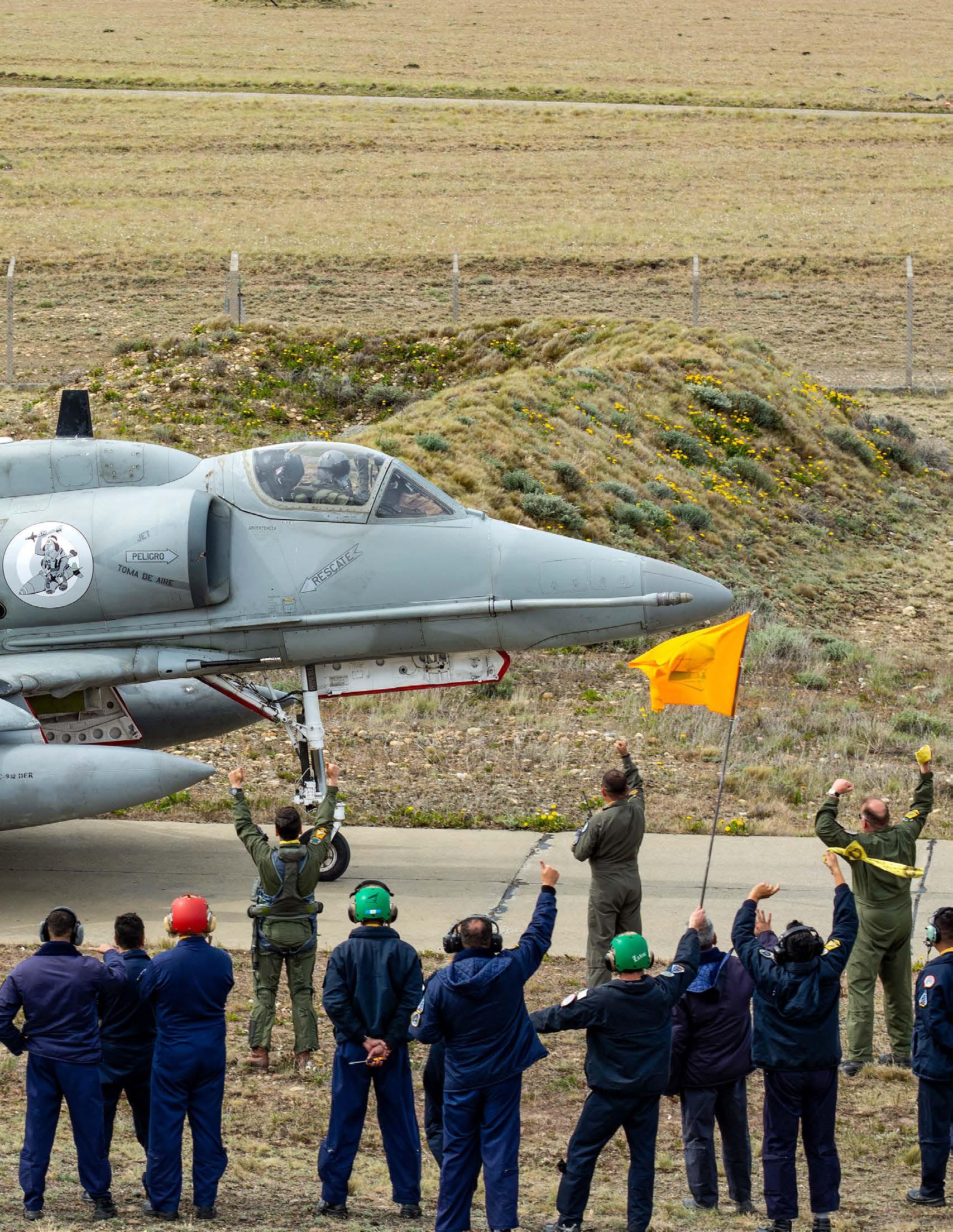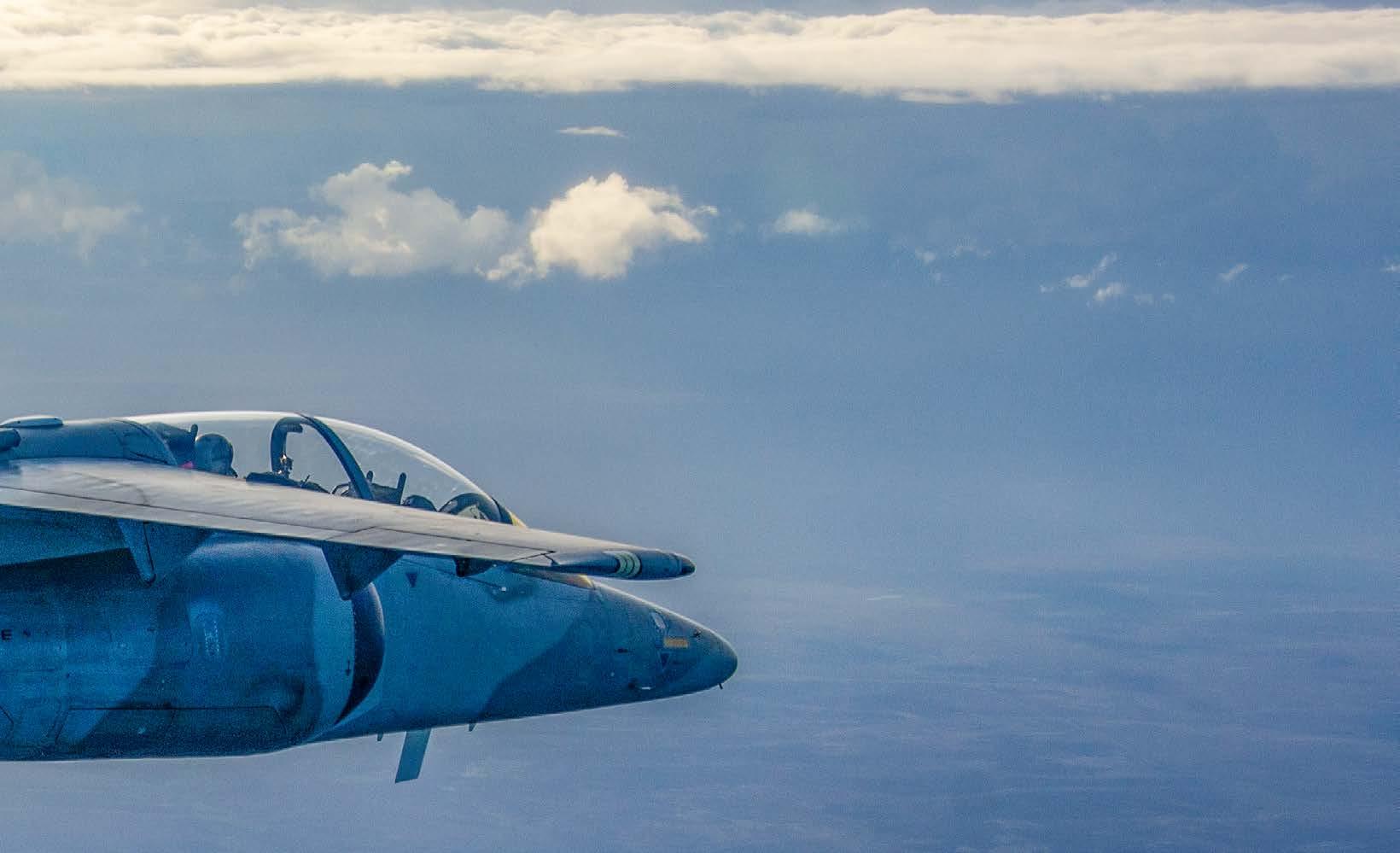
9 minute read
Exercise Soberania - Argentina
EXERCISE SOBERANIA

Advertisement
EXERCISE SOBERANIA

REPORT AND IMAGES BY HORACIO J. CLARIÁ

A-4AR Fightinghawk assigned to the Grupo Aéreo 6 de Caza (Fighter Wing) of the V Brigada Aérea waiting fo take-off clearance

The Argentine Air Force (FAA) conducted the exercise "Soberania 2019" from 10 to 14 November. Despite the decreasing budget situation during the last four years, the Argentine Air Force has managed to keep a quite interesting schedule of exercises and deployments along 2019. "Soberanía 2019" roundedoff the year with some very interesting milestones. This one-week advanced aerial combat training exercise was held in the BAM Río Gallegos, in the southern Patagonia region of Argentina. Its main aim was to offer realistic air-combat training for the Air Force pilots and ground personnel, which included tactical navigations, air to air combat sorties with ground control coordination, plus a combined air operation (COMAO) training, including night flying operations. Also, "Soberanía 2019" became the scenario of three important milestones for the FAA. The A/OA-4AR Fightinghawk fighters from the V Brigada Aérea (Villa Reynolds) have returned to operate in the Southern region of the country for the first time since 2012, deploying five aircraft. For the first time in this region, the VI Brigada Aérea (Tandil) participated with one

A-4AR Fightinghawk (main image) assigned to the Grupo Aéreo 6 de Caza (Fighter Wing) of the V Brigada Aérea and a Mil Mi-17E from the VII Brigada Aérea (inset)


IA-63 Pampa II and three brand new FADEA IA-63 Pampa IIIs. One objective of this event was the launch of a live AIM-9M Sidewinder missile from an A-4AR Fightinghawk. The deployment of the aircraft began on Saturday, 9 November with the support of a Lockheed C-130 Hercules (I Brigada Aérea) and a Saab 340B (IX Brigada Aérea). A Mil Mi-171E helicopter from the VII Brigada Aérea was also enlisted for SAR operations to complement a local Bell UH-1H Huey II from the Sección de Aviación de Ejército 11 (Ejército Argentino). The Grupo 2 de Comunicaciones, based in Comodoro Rivadavia, deployed personnel and equipment to guarantee that the Direx (Exercise Direction) had permanent command and control over the air operations. The Direx was comprised by a staff of officers who assisted and assessed the Exercise Director in different areas such as Personnel, Intelligence, Operations and Logistics. The Escuadrón VyCA 2 (Airspace Vigilance and Control Squadron) from BAM Río Gallegos, operating the recently modernized fixed MTPS-43 radar, played a vital role in the exercise. The air operations were divided into two stages. During the first days, Familiarization (FAM) and Forces Integration Training (FIT) flights took place. The FAM flights are very important at the beginning of every exercise, where the pilots, who normally do not fly

(main image) assigned to the Grupo Aéreo 6 de Caza (Fighter Wing) of the V Brigada Aérea and a Mil Mi-17E from the VII Brigada Aérea (inset) in this region, can adapt to the airfield and operation zones. Southern Patagonia is a very different scenario compared to the ones A-4s and Pampas normally operate. Constant and strong winds prevail in a region with different landscapes such as mountains, coasts, rivers, islands and large plains. The FIT flights consisted in dissimilar air combat training (DACT) between A-4 and Pampa, with 1 versus 1 sorties, gaining more complexity with 2 versus 1 and 2 versus 2 scenarios. Each set up was supported by the Westinghouse MTPS-43 radar operators using several radar consoles. Briefings and debriefings took place in every flight among pilots and controllers to maximize the lessons where Ground Control Intercept (GCI) tactics were introduced. "Soberanía" was a great experience for the Pampa Squadron. This young unit was formed in 2015 when the Mirage / Finger supersonic fighters were withdrawn from service. Originally equipped with the Pampa II, the first Pampa III were received in the second half of 2018. The main difference between both versions is the introduction of a full glass cockpit, a training data link EVA (Embedded Virtual Avionics) and In-flight Electronic Warfare Simulator (IFEWS). These systems enable the Pampa III as a 5th generation fighter trainer with the capability to generate different combat scenarios. During the FIT flights, the pilots and ground

crew rounded-off a year of intensive training reaching the aircraft’s maximum flight envelope and endurance. Moreover, during the 2 vs 2 setups, they performed ground controlled intercept (GCI) night operations using NVG with visual interception and identification against targets (A-4AR) operating in covert mode (no external illumination). These are very complex operations that show the outstanding training level achieved. Tactical navigations were also scheduled during the complete exercise. Navigations included Air Interdiction (AI) missions to attack different groundbased targets, using flight profiles LO-LO-LO, HI-LOHI and a combination of them. At the beginning, these sorties were performed by the A-4AR and the Pampa III separately, ending with combined flights. In one of this sorties, a flight of four Pampa III landed at the Base Aeronaval Río Grande located on Tierra del Fuego island, performing tactical navigations over the Canal de Beagle channel and the Isla de Estados island in the extreme south of the country close to be Chilean border. A dispute with Chile regarding the sovereignty of three islands in this channel almost brought the two countries into an open war in December 1978, the so called "Beagle conflict". During those days, all the Argentine Air Force was deployed in the Patagonia with Chilean targets assigned, plus the Argentine Navy’s task force

OA-4AR Fightinghawk (left), and A-4AR to the Grupo Aéreo 6 de Caza (Fighter Wing) of the V Brigada Aérea

Ready for take-off - one OA-4AR and two A-4AR's lining up at the end of the runway

and A-4AR Fightinghawk (right) assigned to the Grupo Aéreo 6 de Caza (Fighter Wing) of the V Brigada Aérea

Ready for take-off - one OA-4AR and two A-4AR's lining up at the end of the runway including the carrier ARA 25 de Mayo and submarines crossing the Drake Passage in the Pacific Ocean. The COMAOs built the second stage of the drill. Originally, three COMAOs were planned in order to have a Mission Commander of each of the deployed squadrons (A-4, Pampa and Mi-171), but finally only one was executed. In order to rehearse air superiority tactics, offensive counter-air (OCA) and defensive counterair (DCA) operations were conducted by the COMAOs elements. OCA is to destroy, disrupt or degrade enemy air capabilities (runways, launch sites, airfields, etc.) by engaging them as close as possible to their origin. DCA is to protect friendly forces and vital interests from enemy air and missile attacks. Blue and Red Forces were established to simulate a military conflict. In the Blue Force, the A-4AR Fightinghawk played the strikers and sweepers against enemy aircraft or targets of opportunity in a designated area. Also comprising the Blue Force, a flight of Pampas and the Mil Mi-171E / Bell UH-1H helicopters formed a package which performed a Combat Search and Eescue (CSAR) drill in the nearby of BAM Río Gallegos. Pampa III were used as RESCORT (Rescue Escort) to protect the ground personnel to be recovered and the rescue helicopter from ground and air threats. A flight of Pampas flew quick reaction alert (QRA) to protect the airfield against the Red Force. A



Armed with a live AIM-9M Sidewinder air-to-air missile this A-4AR Firehawk taxies to the runway for take-off for the first launch of a live Sidewinder since the A-4AR Firehawk entered service in 1997.




second flight of Pampa IIIs acted as Red Force "bandits" (strikers) which tried to obstruct the CSAR operation and attack the airfield at BAM Río Gallegos. One of the main goals of "Soberanía" was the launch of a live AIM-9M Sidewinder. It was the first time that the A-4AR Fightinghawk fired a live missile since it entered service in 1997. It is necessary to go back to 2008 since the Argentine Air Force fired its lasts Matra Magic II from an AMD-BA Mirage IIIEA, so this event was anticipated with great excitement among the personnel deployed in Río Gallegos. The importance of the event was



First launch ever of a live AIM-9M from an A-4AR of the Argentine Air Force (airto-air photos by FAA via author)



First launch ever of a live AIM-9M Sidewinder from an A-4AR of the Argentine Air Force (airto-air photos by FAA via author) marked by the presence of the FAA's Comandante de Adiestramiento y Alistamiento, Brigadier Mayor Alejandro Amorós, who took part in the launch-flight onboard a two-seater OA-4AR. The exercise ended fulfilling all the planned objectives, sharpening the pilots’ skills, setting a standard for future drills. The main ingredients for this achievement was the great commitment of all the personnel and key leadership carried out by the Direx and the squadron leaders.







IA-63 Pampa III assigned to the Grupo Aéreo 6 de Caza (Fighter Wing) of the VI Brigada Aérea




IA-63 Pampa II assigned to the Grupo Aéreo 6 de Caza (Fighter Wing) of the VI Brigada Aérea



assigned to the Grupo Aéreo 6 de Caza (Fighter Wing) of the VI Brigada Aérea











